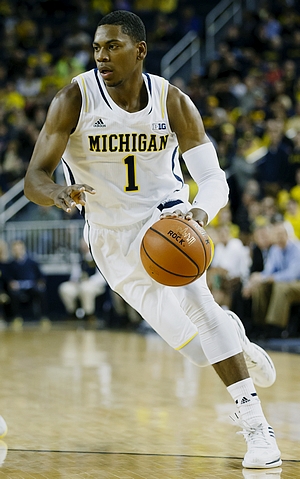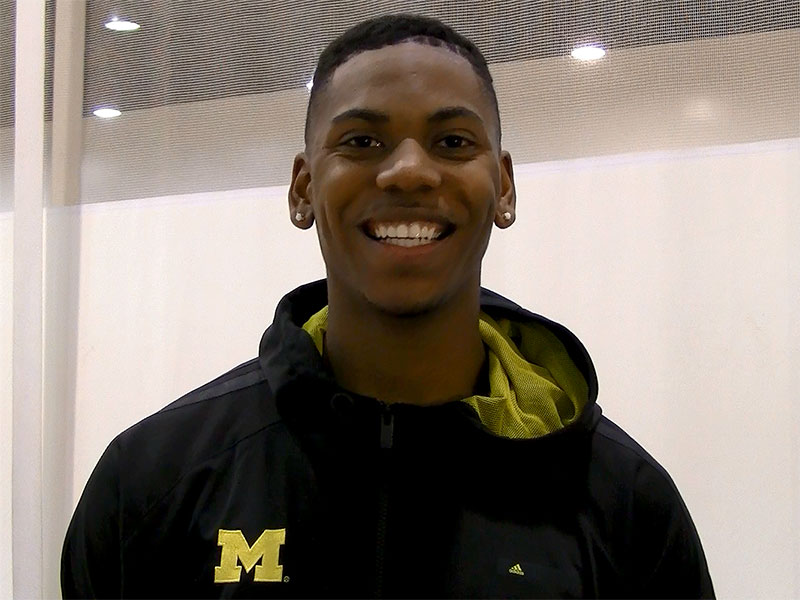#10) Glenn Robinson, 6'7, Small Forward, 22.5 years old, Indiana Pacers, Michigan
EWA: .7
PER: 20.8
TS%: 55.8%
15.6 PTS, 5.6 REB, 2.0 AST, 1.2 STL, 8-21 3PT, 6-11 FTH, 49.2 FG%
Robinson III, a second round draft pick of the Timberwolves in 2014 has bounced around the League, spending time with Minnesota, Philadelphia, and most recently Indiana and one game with their D-League affiliate, the Fort Wayne Mad Ants. Robinson III has the size and athletic ability to be an NBA combo forward but has yet to really show that he has the skills to put it all together, partially due to a lack of opportunity. At his best running the floor and finishing around the rim, he needs to continue to develop some ball-skills to complement his outside shot. Shooting just 32% from 3 throughout his career thus far, Robinson III shot it with some confidence in Orlando going 8 for 21 while showing signs of development. Only 22 years old, despite playing his third year of summer league, if Robinson can continue to polish his perimeter game and play with a consistent motor on the defensive end, he undoubtedly has the physical tools and talent to contribute as a wing player at the NBA level.
Articles
Glenn Robinson 2014 NBA Pre-Draft Workout and Interview Video
Jun 06, 2014, 10:42 am
We joined Glenn Robinson as he works out in preparation for the 2014 NBA Draft, and discussed a number of topics with him, including what he's trying to improve on in the short-term and what he feels he can bring to a NBA team.
Previous 2014 NBA Draft Workout Videos
-Khem Birch
-Gary Harris
-Noah Vonleh
-T.J. Warren
-Elfrid Payton
-Zach LaVine
-Aaron Gordon
-Doug McDermott
-Nik Stauskas
-Adreian Payne
-K.J. McDaniels
-Sean Kilpatrick
-Joe Harris
Previous 2014 NBA Draft Workout Videos
-Khem Birch
-Gary Harris
-Noah Vonleh
-T.J. Warren
-Elfrid Payton
-Zach LaVine
-Aaron Gordon
-Doug McDermott
-Nik Stauskas
-Adreian Payne
-K.J. McDaniels
-Sean Kilpatrick
-Joe Harris
Glenn Robinson Updated Scouting Report
May 29, 2014, 11:39 am
Matt Williams
A year after falling to Louisville in the 2013 National Championship Game, Michigan once again found itself in the Elite Eight, overcoming the departures of Trey Burke and Tim Hardaway and the absence of Mitch McGary to finish the season with a 28-9 record. Though John Beilein's Wolverines fell victim to a surging Kentucky team, his team once against ranked among the top offensive units in college basketball led by fast-rising NBA talents in Nik Stauskas and Caris LeVert.

The highest ranked prospect in Michigan's terrific sophomore class which included McGary, Stauskas, and LeVert, Glenn Robinson was lost in the shuffle this season to some degree. He certainly didn't have a bad year, averaging 13.1 points and 4.4 rebounds per-game while starting every game and earning All-Big Ten Honorable Mention honors for the 2nd straight year, but he was did not improve as much as hoped, and was overshadowed by the rapid improvement of his teammates.
Standing a hair under 6'7 in shoes with a 6'10 wingspan, Robinson's most appealing assets as an NBA prospect have long been his combination of size and outstanding athleticism for a NBA wing. A highlight waiting to happen as a finisher with great speed and quickness, the Indiana native's physical tools have never come into question. However, Robinson has had to try to answer significant questions as to whether he has the skill set and mentality to allow him to use those tools.
As a freshman, Robinson's role revolved around his ability to finish the shots Trey Burke created for him in the half court, look for opportunities to get out in transition, and knock down an occasional spot up jumper. With more than half of his offensive possessions (56.8%) resulting from cuts, fast breaks, and put backs, Robinson played more like a stretch power forward as the combination of his athleticism and Michigan's high powered backcourt helped him rank among the most efficient scorers in the entire country.
With Burke taking his playmaking ability to the NBA, Robinson's role shifted considerably as evidenced by the same cuts, fast breaks, and put backs that helped him earn a spot on the All-Big Ten Freshman Team accounting for just 36.7% of his possessions, as had to create more of his offense for himself from the perimeter. Although he still finished at a tremendous 63% clip inside, the shots around the rim that he had thrived on in the half court shifted toward the midrange and his true shooting percentage fell from 63% to 57% as a sophomore.
While there's little doubt Robinson can be effective living off what's created for him, his ability to create his own from the perimeter leaves something to be desired. He has a solid first step, but lacks the ball-handling ability to shake his defender consistently one-on-one and doesn't always look comfortable handling the ball under duress. Finishing the year with more turnovers than assists, the Indiana native has plenty of room to improve his ability to make things happen when he attacks off the bounce.
Similarly, Robinson has something to prove as a jump shooter. Making 35.4% of his looks with his feet set from the perimeter, he made a respectable 40% of his pull-up jumpers according to Synergy Sports Technology, but his ability to knock down open jump shots and spread the floor limited his overall offensive impact last season. He looked comfortable shooting the ball at the NBA Combine and his misses weren't as erratic as a sophomore as they were as a freshman, but his perimeter footwork and touch from beyond the NBA three point line will still be two things teams pay close attentions to when they work him out as they'll play a key role in just how consistent he can be from distance and in turn how valuable he can be as a roleplayer early in his career.
Defensively, Robinson's physical tools give him plenty of promise at the next level, but doesn't always make the most of them, as he appears to lack a degree of toughness. This is perhaps most apparent on the glass where, despite his outstanding leaping ability, he ranks among the worst rebounding small forwards in our top-100. Mostly defending the power forward position at Michigan, Robinson played with a more consistent motor than he did as a freshman and had some nice moments defending the perimeter thanks to his lateral quickness, but he'll benefit from gaining experiencing defending the small forward position full time and playing with a greater sense of urgency given how much of an impact he appears capable of making on this end of the floor.
The son of 2-time NBA All-Star and Glenn Robinson, who averaged 30.3 points and 10.1 rebounds as a sophomore at Purdue before leaving school and going 1st overall in the 1994 NBA Draft, Robinson has an NBA pedigree, but will need to fill the holes in his game that limited him last season to reach his lofty potential. His athleticism, solid feel for the game, and finishing ability give him upside in a small, hustle-based role next to the right point guard from the get-go, but his ability to improve his perimeter skills, get tougher and become more assertive will determine just how high level a player he can be a few years from now. If Robinson can make some strides in the short term and performer well in workouts, it wouldn't be at all surprising to see him find a home in the early 20's come draft day, as his style of play is tailor made for that setting.
A year after falling to Louisville in the 2013 National Championship Game, Michigan once again found itself in the Elite Eight, overcoming the departures of Trey Burke and Tim Hardaway and the absence of Mitch McGary to finish the season with a 28-9 record. Though John Beilein's Wolverines fell victim to a surging Kentucky team, his team once against ranked among the top offensive units in college basketball led by fast-rising NBA talents in Nik Stauskas and Caris LeVert.

The highest ranked prospect in Michigan's terrific sophomore class which included McGary, Stauskas, and LeVert, Glenn Robinson was lost in the shuffle this season to some degree. He certainly didn't have a bad year, averaging 13.1 points and 4.4 rebounds per-game while starting every game and earning All-Big Ten Honorable Mention honors for the 2nd straight year, but he was did not improve as much as hoped, and was overshadowed by the rapid improvement of his teammates.
Standing a hair under 6'7 in shoes with a 6'10 wingspan, Robinson's most appealing assets as an NBA prospect have long been his combination of size and outstanding athleticism for a NBA wing. A highlight waiting to happen as a finisher with great speed and quickness, the Indiana native's physical tools have never come into question. However, Robinson has had to try to answer significant questions as to whether he has the skill set and mentality to allow him to use those tools.
As a freshman, Robinson's role revolved around his ability to finish the shots Trey Burke created for him in the half court, look for opportunities to get out in transition, and knock down an occasional spot up jumper. With more than half of his offensive possessions (56.8%) resulting from cuts, fast breaks, and put backs, Robinson played more like a stretch power forward as the combination of his athleticism and Michigan's high powered backcourt helped him rank among the most efficient scorers in the entire country.
With Burke taking his playmaking ability to the NBA, Robinson's role shifted considerably as evidenced by the same cuts, fast breaks, and put backs that helped him earn a spot on the All-Big Ten Freshman Team accounting for just 36.7% of his possessions, as had to create more of his offense for himself from the perimeter. Although he still finished at a tremendous 63% clip inside, the shots around the rim that he had thrived on in the half court shifted toward the midrange and his true shooting percentage fell from 63% to 57% as a sophomore.
While there's little doubt Robinson can be effective living off what's created for him, his ability to create his own from the perimeter leaves something to be desired. He has a solid first step, but lacks the ball-handling ability to shake his defender consistently one-on-one and doesn't always look comfortable handling the ball under duress. Finishing the year with more turnovers than assists, the Indiana native has plenty of room to improve his ability to make things happen when he attacks off the bounce.
Similarly, Robinson has something to prove as a jump shooter. Making 35.4% of his looks with his feet set from the perimeter, he made a respectable 40% of his pull-up jumpers according to Synergy Sports Technology, but his ability to knock down open jump shots and spread the floor limited his overall offensive impact last season. He looked comfortable shooting the ball at the NBA Combine and his misses weren't as erratic as a sophomore as they were as a freshman, but his perimeter footwork and touch from beyond the NBA three point line will still be two things teams pay close attentions to when they work him out as they'll play a key role in just how consistent he can be from distance and in turn how valuable he can be as a roleplayer early in his career.
Defensively, Robinson's physical tools give him plenty of promise at the next level, but doesn't always make the most of them, as he appears to lack a degree of toughness. This is perhaps most apparent on the glass where, despite his outstanding leaping ability, he ranks among the worst rebounding small forwards in our top-100. Mostly defending the power forward position at Michigan, Robinson played with a more consistent motor than he did as a freshman and had some nice moments defending the perimeter thanks to his lateral quickness, but he'll benefit from gaining experiencing defending the small forward position full time and playing with a greater sense of urgency given how much of an impact he appears capable of making on this end of the floor.
The son of 2-time NBA All-Star and Glenn Robinson, who averaged 30.3 points and 10.1 rebounds as a sophomore at Purdue before leaving school and going 1st overall in the 1994 NBA Draft, Robinson has an NBA pedigree, but will need to fill the holes in his game that limited him last season to reach his lofty potential. His athleticism, solid feel for the game, and finishing ability give him upside in a small, hustle-based role next to the right point guard from the get-go, but his ability to improve his perimeter skills, get tougher and become more assertive will determine just how high level a player he can be a few years from now. If Robinson can make some strides in the short term and performer well in workouts, it wouldn't be at all surprising to see him find a home in the early 20's come draft day, as his style of play is tailor made for that setting.
Top NBA Prospects in the Big Ten,Part 1: Glenn Robinson Scouting Video
Sep 16, 2013, 03:31 pm
Mike Schmitz is the video analyst for DraftExpress. Follow him on twitter and subscribe to the DraftExpress YouTube page. He will be breaking down the NBA draft in digital format all year long for us.



























Comments